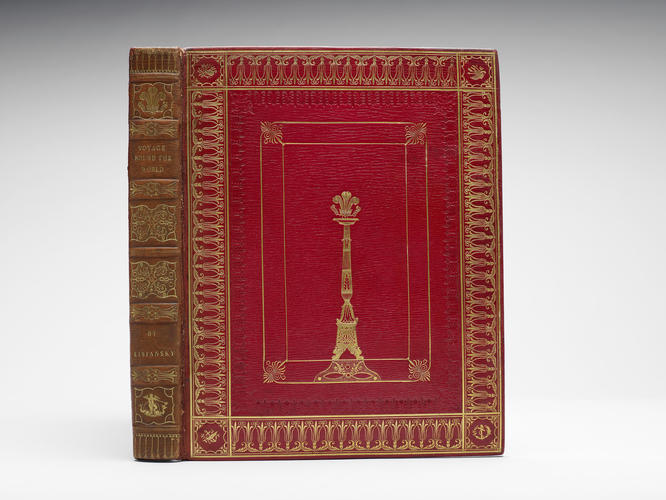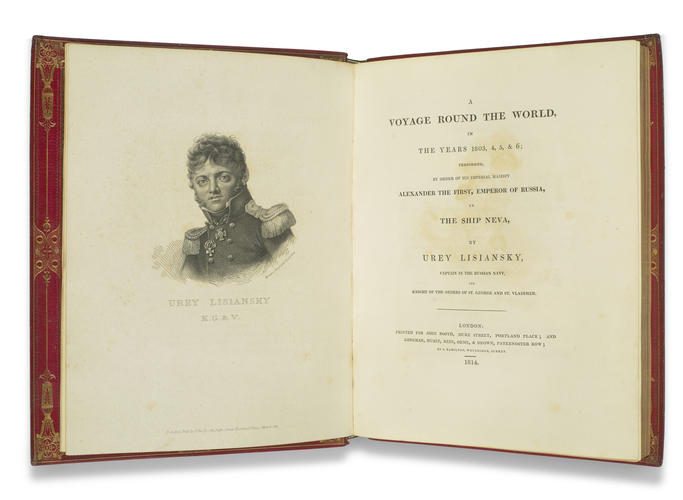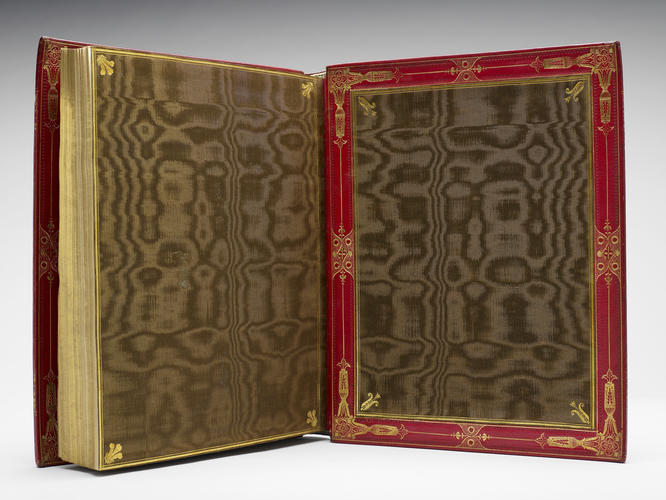A Voyage round the world in the years 1803, 4, 5, & 6: performed, by order of His Imperial Majesty Alexander the First, Emperor of Russia, in the ship Neva 1814
28.8 x 20.7 x 3.2 cm (book measurement (conservation)) | RCIN 1141469

Yuri Lisianskyi (1773–1837)
A Voyage round the world in the years 1803, 4, 5, & 6: performed, by order of His Imperial Majesty Alexander the First, Emperor of Russia, in the ship Neva / by Yuri Lisianski 1814

Yuri Lisianskyi (1773–1837)
A Voyage round the world in the years 1803, 4, 5, & 6: performed, by order of His Imperial Majesty Alexander the First, Emperor of Russia, in the ship Neva / by Yuri Lisianski 1814

Yuri Lisianskyi (1773–1837)
A Voyage round the world in the years 1803, 4, 5, & 6: performed, by order of His Imperial Majesty Alexander the First, Emperor of Russia, in the ship Neva / by Yuri Lisianski 1814

Yuri Lisianskyi (1773–1837)
A Voyage round the world in the years 1803, 4, 5, & 6: performed, by order of His Imperial Majesty Alexander the First, Emperor of Russia, in the ship Neva / by Yuri Lisianski 1814





-
Yuri Lisianskyi (1773–1837) was a Ukrainian officer in the Russian Imperial Navy who, with the ship Neva, participated in the first Russian circumnavigation of the world in 1803-6. Leaving Kronstadt, near St Petersburg, in August 1803, the aim of the voyage was to establish diplomatic relations between Russia and Japan, as well as to open Chinese ports to Russian fur traders. Lisianskyi commanded the second of the two vessels, the leader of the exhibition being Adam Johann von Krusenstern (1770–1846), who captained the lead ship, Nadezhda.
Making stops in Denmark, Tenerife and Brazil before crossing into the Pacific, storms split the two ships and Lisianskyi led the Neva to Easter Island (Rapa Nui), where he produced a significant report on the island’s population. Lisianskyi then sailed to Nuku Hiva, the largest islands in the Marquesas Islands, where he regrouped with Krusenstern. The ships then sailed north to Hawai’i, arriving in late May 1804. On 15 June, a group of American fishermen arrived at Neva and informed Lisianskyi of a Tlingit assault of the Russian fort at Sitka in Alaska, part of an ongoing conflict between Russian settlers and the Indigenous population. Five days later, Lisianskyi set sail for Alaska while Krusenstern began preparations for the embassy to Japan.
Reaching the colonial capital, Kodiak in July 1804, Lisianskyi was soon commissioned by the governor Alexander Baranov (1747–1819) to lead an attack on the Tlingit Kiks.ádi clan, who, expecting Russian reprisals at Sitka, had constructed a fortification, Shís’gi Noow (Fort of the Young Saplings) in the area. In late September, Lisianskyi landed nearby, and Baranov sent envoys to negotiate a Tlingit surrender. The Kiks.ádi leadership hoped to delay the Russians so that they could occupy Shís’gi Noow in secret. However, Russian forces spotted a group of Tlingit fetching munitions and following a brief firefight, the negotiations collapsed. On 1 October, Baranov gave orders for Neva to bombard the fort.
The resulting battle lasted four days with Baranov being wounded during the first day’s action, causing Lisianskyi to assume command. Despite the strength of the Tlingit fort preventing Russian ammunition from penetrating its defences, on 2 October, Kiks.ádi leaders began to plan for the entire population to abandon Shís’gi Noow under the cover of darkness, embarking on a long march to Old Sitka (Gaaja Héen) and thence to Chichagof Island (Shee Kaax). Once plans were in place, ceremonies were held on the evening of 4 October and the fort was abandoned. On discovering the empty fort, Lisianskyi sent scouts to search the surrounding area, but no trace of the Kiks.ádi could be found. Lisianskyi visited Shís’gi Noow on 8 October. He later reported in his account that all that remained were the bodies of children killed during the battle, claiming instead that they had been killed by their parents ‘ lest their cries… should have led to a discovery of the retreat’. In reality, the elderly, women and children had left Shís’gi Noow before dawn on 4 October. He ordered the fort to be destroyed and Neva left Alaska the following month, meeting Krusenstern at Macau in 1805. The battle at Sitka was the last armed conflict between Russian settlers and Tlingit groups. After resettling on Chichagof Island, the Kiks.ádi warned other Tlingit clans to avoid contact with Russians as much as possible. Sitka was reinforced several times in the nineteenth century and served as the most important Russian settlement in Alaska until the American purchase of the colony in 1867.Lisianskyi returned to Russia in July 1806 and was awarded the Order of Saint Vladimir by the tsar, Alexander I, for his actions. He then set about writing his account of the voyage, publishing it in Russian in 1812.
This copy of the English edition, published by John Booth in 1814, was acquired by the Prince Regent, later George IV for his library at Carlton House. One of the subject strengths in the Prince Regent’s library was travel and exploration, which may account for this superbly tooled volume on Lisianskyi’s circumnavigation of the world. The book is bound in red goatskin, with gold and blind tooling, featuring the Prince of Wales Feathers badge, and maritime motifs (anchors, dolphins and tridents) in the corners of the border.
Provenance
Presented to George IV when Prince Regent, c.1814
-
Creator(s)
(publisher)(printer)Acquirer(s)
-
Measurements
28.8 x 20.7 x 3.2 cm (book measurement (conservation))
28.8 x 3.2 x 20.7 cm (book measurement (inventory))
Markings
annotation: Dedication to Alexander I, Emperor of Russia [front flyleaf]
Category
Alternative title(s)
A Voyage round the world in the years 1803, 4, 5, & 6: performed, by order of His Imperial Majesty Alexander the First, Emperor of Russia, in the ship Neva / by Yuri Lisianski
A Voyage round the world in the years 1803-6 ; performed, by order of His Imperial Majesty Alexander the First, Emperor of Russia, in the Ship Neva / by Urey Lisiansky, captain in the Russian Navy...








